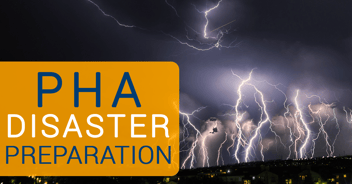How to prepare your PHA for potential disasters - Part 3

Disasters often strike unexpectedly and include a wide range of events. That’s why it’s important to be prepared before a disaster hits your community. By planning for disasters before they happen, you can help ensure your PHA has adequate resources and is ready to respond should a disaster affect your area. The information presented below aims to help your PHA create proper disaster plans and procedures as well as utilize all funding and resources that may be available during and after a disaster. This is a four part series, so be on the lookout for part four coming out next week!
Coordination and partnerships, working with local resources and funding sources
PHAs should identify and communicate with local resources that may be able to assist during and after a disaster. Many organizations specialize or have experience in disaster response and recovery efforts and may be able to assist in different areas of the planning and recovery effort. Local resources are a great way to acquire the aid you might not have the resources to provide yourself.
Identifying resources
The first step in working with local aid is to identify resources and partner agencies in your area. PHAs should identify all possible resources and services available. Your list should include government services (municipal, county, state, HUD, and FEMA), first responders, non-profit and charitable organizations (The Red Cross, food banks, fair housing organizations, etc.), and contractors and services (utilities, insurance, emergency contractors, etc.). Often times during and after a disaster, there is a lack of availability from contractors to conduct essential services like debris removal and temporary housing/shelters. By having a list of potential emergency contractors available to provide essential services, you help mitigate the risk of lacking the resources to deal with key, short-term and emergency recovery efforts. Contractors should be contacted and informed of the services that may be needed should a disaster occur.
Funding Sources
When disasters occur, there are often times multiple types of funding sources available. The efforts and steps described above can help PHAs better be prepared for such funds, as well as help ensure that they qualify for funds. Each funding source will have unique sets of requirements, but all will require some level of justification and documentation of the costs incurred and expected during and after a disaster.
Funding sources–insurance
It is essential that PHAs have adequate insurance, not only for protection in the case of a disaster, but also because it is a requirement of the PHA’s Consolidated Annual Contributions Contract (CACC) with HUD. The CACC requires that all public housing developments are covered by adequate insurance.
If your PHA has developments located in a floodplain, your PHA must have flood insurance for those developments. A lack of flood insurance for these properties will automatically disqualify you from receiving Federal Emergency Management Agency (FEMA) funds which is one of the largest funding pools available for disaster recovery. Be sure to check FEMA’s floodplain map for changes due to erosion, climate, and weather patterns to keep up to date on the current map (note, FEMA does not send out notifications when changes have been made, so have your PHA check the map regularly).
Funding sources–capital fund program
Another more common funding source available for disaster preparedness is the capital fund program. While there a typically more capital needs than funds available to PHAs, it is recommended that you utilize the risk assessment described above to identify preventive opportunities that can be financed with capital funds. Here you can look at improving building envelope/structures to minimize damage from anticipated disasters. Capital funds are also available to be used in coordination with other disaster funds to repair capital damage.
Funding sources–state and local funds
States and local municipalities often times have various types of funding available that may be used for certain types of disaster preparedness and recovery efforts. One of the largest sources of disaster preparedness and recovery funding available is through the Community Development Block Grant–Disaster Recovery program. These funds are allocated from congress to HUD, and HUD generally allocates funding to states, counties, and cities affected by eligible disasters. If CDBG-DR funding becomes available for your jurisdiction there is typically an application process created in order to distribute the available funds. It is beneficial for PHAs to establish contacts at a state or local disaster coordinating office to ensure your PHA is notified if funding becomes available, and to acquire information regarding the application process.
Funding sources–FEMA
Generally, there are 3 types of programs available through FEMA: public assistance, transitional shelter assistance, and hazard mitigation planning and assistance. In addition to these three, there is also assistance available directly to residents and to PHAs.
When it comes to applying for FEMA, documentation is crucial and PHAs should enact safe, efficient, and proper record management prior to and after disasters. In the past PHAs have been denied FEMA or insurance funds because of a lack of documentation.
Funding sources–other types of funds
PHAs should also consider assistance that may be available from charitable organizations, which may be able to provide immediate or long-term supplies and assistance to help you and your residents. PHAs may also benefit from a disaster specific housing assistance program which are established in response to a presidentially declared emergency. Disaster Housing Assistance Programs can be used to increase housing stock on affordable single-family homes and rentals. (Note that although Disaster Housing Assistance Programs can be a great resource, you should not rely on getting this funding so be sure to look at other potential funding sources.)
Duplication of Benefits
After receiving, and while utilizing your funding, you need to make sure there is no Duplication of Benefits (DOB). A duplication of benefits occurs when federal aid is used to pay for work or services already funded by another agency, insurance, or program. To properly calculate and avoid DOB’s, it is important to adequately track assistance and funds as they are obtained and expended. Tracking each funding source separately and in detail will help to identify potential gaps in funding and will assist in ensuring a duplication of benefits does not occur. One way to ensure funds are tracked correctly, is to incorporate this into your PHA’s continuity plan (ensuring financial procedures and policies include proper tracking mechanisms and systems).
Next: Putting plans into action: what happens after a disaster
About the author

With nearly a decade of experience in the affordable housing industry, James Karner has served with Nan McKay & Associates since 2012 in various roles including quality control, finance, procurement, compliance, and as a trainer. He is currently based in NMA’s Houston office, where he actively works on several CDBG-DR projects including Harris County, Texas and Joplin, Missouri.




